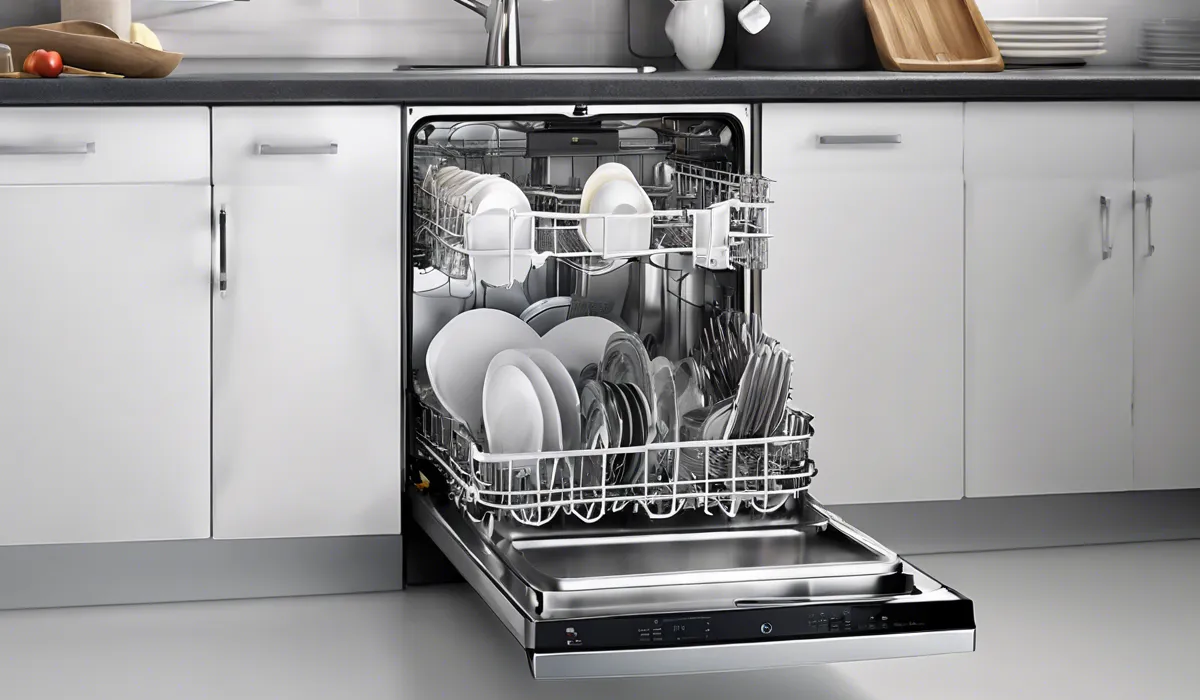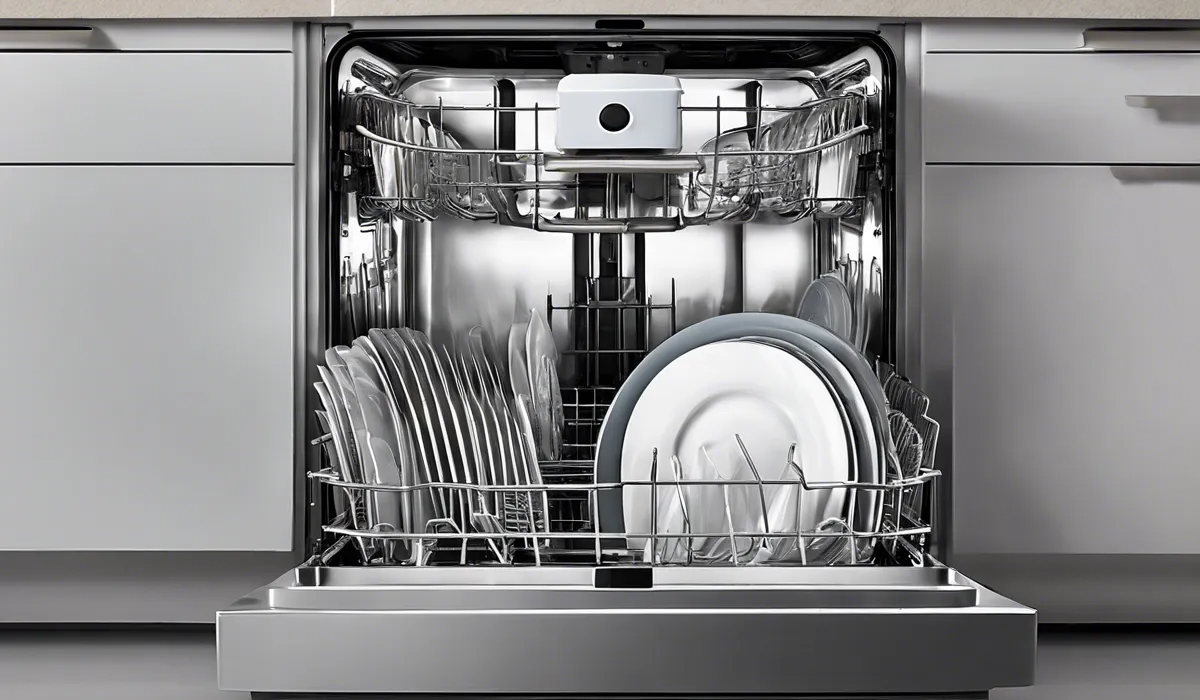How Do a Dishwasher Work: Inside the Cleaning Cycle
A dishwasher works by spraying hot water mixed with detergent onto the dishes. The water is then heated and recirculated to remove food and grease. After washing, it drains the dirty water and sprays clean water to rinse. Lastly, it dries the dishes using heated air.
Dishwasher Design and Components

Exploring the Dishwasher’s Physical Structure
A dishwasher is typically a rectangular appliance that fits under a kitchen counter, often next to the sink for easy plumbing connections.
Standard units are about 24 inches wide, although compact models can be around 18 inches.
The interior boasts racks, baskets, and holders designed to secure dishes, glasses, and silverware, maximizing the space to clean as many items as possible in one cycle.
Internal Mechanics: Racks, Baskets, and More
The interior of a dishwasher includes adjustable racks to accommodate various dish sizes.
Baskets and holders are strategically placed to ensure silverware and small items remain in place during the vigorous washing process.
This design helps to protect delicate items from damage, while ensuring they are thoroughly cleaned.
The Cleaning Powerhouses: Sprayer Arms and Nozzles
At the heart of the cleaning process are the sprayer arms and nozzles, which distribute water and detergent throughout the unit. They rotate and spray jets of water at high pressure to reach every surface of the dishes.
Heating Elements: Ensuring Effective Clean
Heating elements are crucial for raising the water temperature to levels that sanitize dishes and aid in drying them at the end of the cycle.
The heating element can be located at the bottom of the dishwasher or hidden within the unit to prevent accidental contact and to provide more space for dishes.
Dispensers and Controls: Detergent and Customization
The detergent dispenser holds and releases the cleaning agent at the appropriate time in the cycle, while the control panel offers various settings to customize the wash for different loads.
Some advanced models may offer smart features that can be controlled remotely.
Key Component Functions Explained
Key components such as the water inlet valve, pumps, filters, and sensors work in harmony to ensure the dishwasher operates smoothly.
The inlet valve controls the flow of water into the machine, while the pump circulates water during the wash and drains it afterward.
Filters trap food particles to prevent clogging, and sensors monitor the dishwasher’s performance, adjusting the cycle as needed.
The Dishwashing Cycle

Stages of a Dishwasher Cycle
The dishwashing cycle begins with a pre-wash or rinse to loosen food particles. The main wash then uses hot water and detergent to break down grease and food residue.
Following this, one or more rinse cycles remove any remaining detergent and food particles, and a final drying phase leaves dishes dry and ready to use.
Detergent and Water: The Dynamic Duo
Water is heated and circulated by the pump, ensuring it reaches the right temperature to activate the detergent, which is released at a calculated time.
The importance of water temperature cannot be overstated—it must be hot enough to effectively clean but not so hot as to damage delicate items or the dishwasher’s components.
Understanding the Cleaning Process
As the spray arms rotate, they distribute water in specific patterns, ensuring that all surfaces are reached.
This dynamic action dissolves and washes away food particles and grease. Subsequent rinses clear away any remaining residue, leaving dishes spotlessly clean.
Dishwasher Maintenance and Efficiency

Regular Maintenance: Keeping Your Dishwasher at Peak Performance
To maintain a dishwasher, regularly clean filters and inspect spray arms for clogs.
Seals and edges should be wiped down to ensure a tight seal, and the detergent dispenser must be checked and cleaned to prevent buildup that could affect performance.
Tips for Efficient Dishwasher Use
Efficient use of a dishwasher involves proper loading techniques to ensure water can reach all items.
Selecting a suitable detergent and rinse aid enhances cleaning effectiveness, and choosing the right cycle can save energy while still providing a thorough clean.
Running full loads and selecting eco-friendly cycles are excellent energy-saving practices.
Troubleshooting Common Dishwasher Issues
When facing clogs and blockages, check filters and spray arms for debris. Leaks or drainage problems may require examining seals or the plumbing connections.
If cleaning performance is poor, consider whether inappropriate loading, detergent choice, or a malfunctioning component may be the culprit.
FAQs About How Dishwashers Work
How does a dishwasher clean dishes?
A dishwasher cleans dishes by spraying them with hot water mixed with detergent, then heating and recirculating the water to remove food and grease.
What happens to the water after washing the dishes in a dishwasher?
After washing, the dishwasher drains the dirty water and sprays the dishes with clean water to rinse them.
How does a dishwasher rinse dishes?
A dishwasher rinses dishes by spraying them with clean water after the initial wash and drain cycle.
Does a dishwasher dry the dishes after washing them?
Yes, a dishwasher typically dries the dishes after washing and rinsing by using heated air.
Is pre-rinsing dishes necessary before loading them into a dishwasher?
Pre-rinsing dishes is not always necessary before loading them into a dishwasher, as modern dishwashers are designed to handle food and grease residue.
Final Thoughts
A dishwasher operates by spraying dishes with hot, detergent-laced water, which is then heated further for continued circulation, effectively removing food and grease.
Post-washing, it ejects the soiled water and employs fresh water for rinsing. The cycle concludes with the deployment of heated air to dry the dishes, ensuring they are clean and ready for use.





